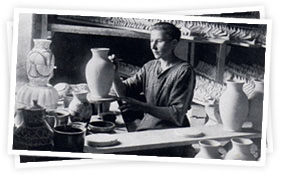History of Polish Pottery
The Art of Polish Pottery, as we know it today, started as local folk art centuries ago in the German province of Silesia. The first known pieces of “Bunzlauer” stoneware dating back to the 16th century were crafted by hand and decorated with a folk art stamping technique using potatoes. Original designs were inspired by the peacock feather using the colors of cobalt blue, sage green and ferrous red. These designs and colors are still the inspiration for modern day patterns.

Today, skilled Polish artists still individually handcraft and hand decorate each piece using small sponges to stamp each pattern and color. After the process of mixing ingredients, molding the pottery, applying the decorations and glaze, the pottery is twice fired. This process makes the pottery extremely durable — it will not crack or chip easily — and it is perfect for use in the microwave, dishwasher, oven and freezer.
We are featuring pottery on this site from five of the largest factories — Zaklady, Vena, Ceramika, Manufaktura, and WR Unikat. They use virtually the same raw materials and time-honored techniques to craft the pottery, but each offers unique patterns and shapes to satisfy individual tastes. While traditional patterns remain most popular, there are literally hundreds of patterns produced.

